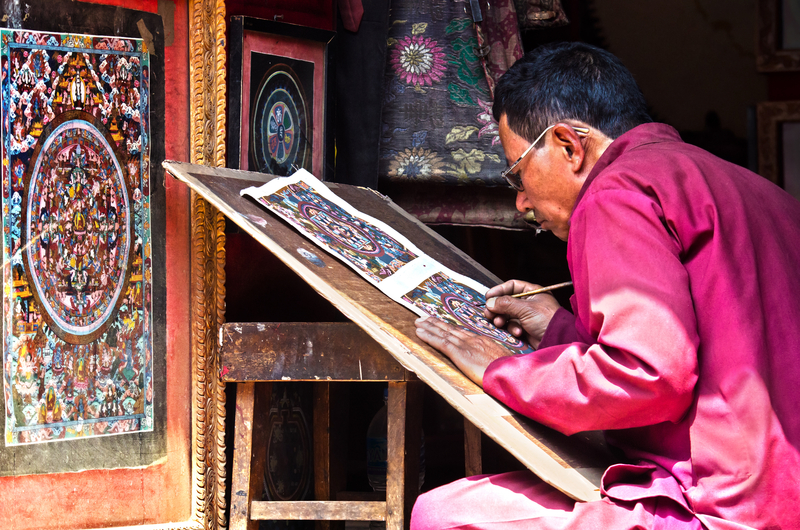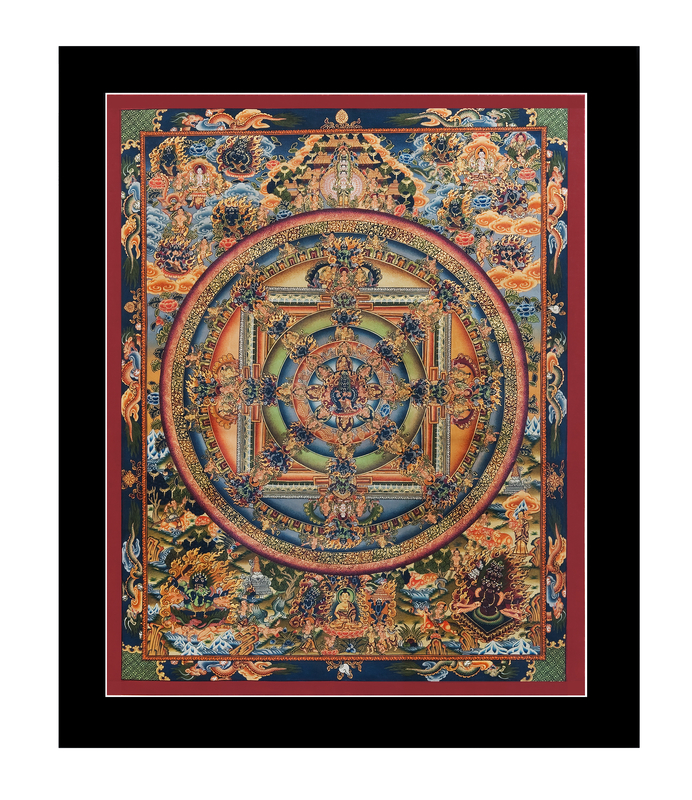Mandala Thangkas

My first encounter with Tibetan thangka painting was in the busy streets of Kathmandu. We had gone to see a temple. I’ve forgotten which one by now. Our taxi parked just outside the temple district and we walked the rest of the way, shuffling through a crowd of mostly ethnic Tibetans and Western tourists. Along the alleys leading up to the temple entrance, the sounds of prayer bells and meditation bowls sang out gently, softened in their resonance against walls draped with colorful sheets of cotton and silk. Drawn to the brilliant imagery, I browsed the stands and spoke with the artists, inquiring about the meaning of each painting, marveling at the detail. I don’t remember the temple, but I’ll never forget the walk up to its doors.
History and Form
Thangka is a traditional Buddhist art form arising at the confluence of the Indian, Arab, and Chinese worlds along the Silk Road. The earliest forms of art thought to have influenced and developed into thangka survive in the Mogao Caves of Western China, which were filled with art and scripture by passing travelers as early as the 4th century CE. Tibetan Thangka definitively emerges by the 11th century.
Mostly, Thangka are small paintings done on sheets of silk or cotton, rarely exceeding 20 inches in size. The emphasis is on detail rather than scale, and that is the first thing that will strike you about thangka painting, the extraordinarily meticulous detail. Thangkas are painted by monks or lay Buddhists and the art is highly regarded as an achievement in skill and accumulation of karmic merit. Each thangka produced by an artist earns him a karmic improvement.
Rich amber-orange hues, fine golden line work, and lapis-lazuli blue sky backgrounds typify the thangka aesthetic, which is always colorful and fantastic. Though there are many types of thangkas, usually thangkas depict a central deity. They may also commemorate the life of an influential lama or bodhisattva. Thangkas are occasionally historical, with a narrative function, and help communities of monks and other Buddhists to remember and retell stories that are important to their tradition. Apart from these teaching and pneumonic functions, thangkas are also used in meditative practice. This is especially true with mandala thangka.

Mandala Thangka
In Tibetan Buddhist practice, mandalas represent the pure and sacred space consecrated by the power of a buddha or other deity. Through concentrated meditation on the mandala, a monk learns information about the deity that is conveyed in the art. Beyond this, he strives to “enter” the mandala, not only invoking the qualities of the deity, but internalizing them himself.
There are many different mandalas that frequently appear as thangkas. Three of the most famous include:
- The Kalachakra Mandala
- The Medicine Buddha Mandala
- The Wheel of Life
The Kalachakra Mandala
This mandala portrays the five story palace that is the realm of Kalachakra, the deity who personifies time. Arrayed around his palace are 722 other minor deities. As with most mandalas, the precise geometric structure of this image is striking. Six circles are inscribed around five squares, depicting the five levels of the palace and the grounds outside of it, which are elemental and conceptual realms. At the center of the mandala is Kalachakra himself.
Medicine Buddha Mandala
This is a mandala for healing. It is painted and meditated upon to heal physical and spiritual ailments and promote health in the Buddhist world. At the center is the Buddha Bhaisajyaguru.
The wheel of life is a circle held by a demon. In the circle are depicted the six (or sometimes five) realms of suffering. These are usually divided into three higher realms of gods and humans, and three lower realms of demons, ghosts, and animals.
